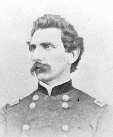 Open main menu
Open main menu
 Open main menu
Open main menu

J. F. Hartranft
(1830 - 1889)
Home State: Pennsylvania
Education: Union College, Class of 1853
Command Billet: Commanding Regiment
Branch of Service: Infantry
Before Antietam
After graduating in 1853, he worked briefly as a civil engineer for the Mauch Chunk and Wilkes-Barre Railroad before accepting a position as a deputy sheriff in Norristown. There he soon became a lieutenant colonel in the militia and was admitted to the bar. In 1854, Hartranft married Sallie Douglas Sebring of Easton, daughter of a judge, and together they had six children.
When the Civil War began, he was given command of the Fourth Pennsylvania Volunteers from Montgomery County. This regiment, comprised of ninety-day enlistees, humiliated Colonel Hartranft at the Battle of Bull Run on July 21, 1861, by walking away because their enlistments expired that same day. Although Hartranft stayed to fight, [and was awarded the Medal of Honor for his valor there] his personal reputation was called into question, until he commanded a new regiment by November, the 51st Pennsylvania Volunteers.
On the Campaign
Along with the 51st New York, his 51st Pennsylvania were the first men to successfully storm the Lower Antietam (later Burnside's) Bridge, at about 1 pm on the 17th. He also led his Regiment in the Ninth Corps assaults to the outskirts of Sharpsburg later in the afternoon.
The rest of the War
In December 1863, after a grueling campaign, relatively high loss of life, and facing new battles, Hartranft's men were again approaching the end of their enlistments. A speech by Hartranft extolling the virtues of the Union's grand cause is credited with the men reenlisting. Despite his reputation of good judgment through twenty-three battles, Hartranft was not promoted to general until after his forces crushed the last significant counterattack by the Confederate army in March 1865.
After the War
His last Army assignment was as the provost marshal of Washington Arsenal prison, where it was his responsibility guard and later to signal the executioner to carry out the death by hanging sentence of the four Lincoln assassination conspirators. (see a photo of the Gen. Hartranft and his staff in Washington, DC). After leaving the Army, he began his political career and was an early associate of the Simon Cameron political machine, serving as auditor general under Governor Geary from 1866 to 1873. He became Cameron's personal choice to succeed John Geary as Pennsylvania Governor and defeated Charles B. Buckalew in the election of 1872. He served two terms, ending in 1879.
At the Republican National Convention in Cincinnati in 1876, during his 2nd term as Governor, Hartranft was nominated as a "favorite son" candidate for President in an effort to stop Senator James G. Blaine of Maine, also a Pennsylvania native. It succeeded since the Convention compromised on an independent Republican and Civil War General, Gov. Rutherford B. Hayes of Ohio, who won the election.
After leaving office, he headed the Pennsylvania National Guard and implemented several reforms of its system. He was appointed postmaster of Philadelphia and later Collector of the Philadelphia Port.
At least as early as 1873, he had a condition of uremia, known as Bright's Disease, which damaged his kidneys and ultimately caused his death on October 17, 1889. Hartranft was buried in Montgomery Cemetery, Norristown. Ten years after his death, a heroic bronze, mounted statue of him was dedicated on the grounds of the State Capitol with Civil War veterans turning out en masse. It can be seen there today near south side of the building.
More on the Web
Nice bio at the Pennsylvania Governor's site; source for much of the text above.
Birth
12/16/1830; Montgomery County, PA
Death
10/17/1889; burial in Montgomery Cemetery, Norristown, PA